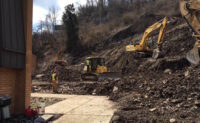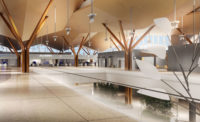About a month after winning a nearly $6-million general works package as part of a $1.4-billion modernization at Pittsburgh International Airport in December 2021, Waller Corp. mobilized staff, including a superintendent, safety manager and seven laborers to start. The Washington, Pa.-based minority-owned general contractor/construction management firm will increase the number of laborers on the job as it progresses.
Ann Sekely, vice president of business development for Waller, praises the airport's work to increase disadvantaged contractor participation in construction during the last few years, saying they "have done a tremendous job of promoting MWBE firms and holding the larger firms accountable in meeting the airport's participation goals on every project put out for bid.”
Airport officials say 142 MWBE firms are working on the terminal modernization program. The project is currently on target to meet its hiring goal of 14% minority and women-owned business enterprises (MWBEs) participation. “We are forecasting to exceed our DBE participation goal by the end of the project in 2025,” says Bob Kerlik, a spokesperson for the Allegheny County Airport Authority.
While controversy swirls around MWBEs on a $1.5-billion Kanas City International Airport project, Pittsburgh's airport officials say ensuring an adequate number of disadvantaged contractors as part of construction work has been an ongoing process. The airport's efforts to increase disadvantaged contractor participation includes removing barriers to participation by unbundling contracts, through outreach in the community to inform contractors of jobs, and by holding owners accountable to meet standards for contractor participation.
Boots On the Ground
Founded in 1986, Waller Corp., which has 45 employees and $22.5 million in revenue last year, completed a first-floor renovation at the Allegheny County airport terminal last fall.
Sekely credits Jenee Oliver, business diversity outreach manager for the Allegheny County Airport Authority, for "working with those larger firms to find the right MWBE fit for a specific project.”
One larger firm working at the airport that is committed to diversity is Fay. The Pittsburgh-based contractor is committing about 14% of the work on a $155-million infrastructure package to MWBEs. The 36-month infrastructure project will connect the roadway system around the airport with the new terminal, in part by way of a 1,300-ft-long double-decker bridge.
Twelve minority-owned contractors who are working or will work for Fay will handle aspects of the project such as signs and lighting, furnishing and installation of rebar and concrete, maintenance and repair of traffic, and bridge painting. The disadvantaged contractors will handle bridge rail installation, prefabricated concrete walls, and other tasks.
"We’ve used a lot of minority contractors and vendors over the years,” says Ryan Surrena, vice president of operations for Fay. “We’re always looking to add more to our list of qualified subcontractors and vendors.”
The work will involve construction of a roadway, the terminal bridge atop an existing bridge and building four smaller bridges for a roadway into the terminal. The new terminal bridge accounts for about half the project value.
“This project is one our employees can be proud to be part of,” Surrena says. “This dual-level bridge will be seen for several decades, and our employees’ part in that will be visible, showing the community our continued dedication to infrastructure in Pittsburgh.”
That project is expected to be completed along with the new terminal in 2025. Fay’s scope includes installation of sewer lines, water lines and electrical conduits as well as new electrical switchgear for the new terminal.
Surrena says coordinating with other airport contracts is challenging. For example, crews recently installed two 50-ton steel girders to form a structural slab foundation using a 200-ft crane. The effort required shutting down trains that run between terminals so that approximately 80-ft long, 100,000-lb steel embedded plate girders could be placed to form the structural slab foundation upon which the new terminal will be built.
Additional steel for the new terminal is expected to begin rising later this spring, including a third similarly sized girder scheduled to be placed over the train tunnel in April.
“We do not want to impose any added building loads to the existing tunnels, so this structural slab diverts the loads away from the tunnels to the auger pilings and the earth underneath,” Rob Bramblett, project executive with the terminal construction management joint venture of PJ Dick–Hunt said in a statement.
Airport officials say the overall modernization effort is on time and on budget.
Bridging Communities
For years, airport officials have been meeting with disadvantaged contractors, informing them of work opportunities, and preparing them to take advantage of the opportunities when needed. Focused meetups with titles such as “Are You Ready To Do Business,” and “Meet The Primes” have helped local minority contractors connect with opportunities, and meet their future project partners.
Airport officials have held 50 outreach events for disadvantaged contractors since 2018, according to Kerlik, the airport spokesman.
Airport official also partnered with local banks to ensure that local, qualified contractors can be qualified to do so through bonding.
The effort both strengthens families and binds the community together, says Oliver, the airport authority's business diversity outreach manager. “With this project, we did a lot of seeding in the community—a lot of meet and greets,” she says. “We were able to bring on a lot of small businesses that had never worked on the airport.”
Sekely says a collegial working relationship between airport officials and contractors helps the work progress.
“The airport staff works alongside our staff to help us when we need guidance,” Sekely says. “We like being a part of a project that will not only help make the airport work better for the community but improve travel to and from our region.”






Post a comment to this article
Report Abusive Comment